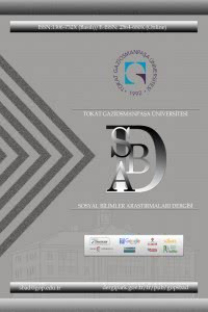“LÂ: SONSUZLUK HECESI” ADLI ROMANDA AYNA METAFORU
metafor, ayna, Lâ: Sonsuzluk Hecesi, yansıma, Adam, Nazan Bekiroğlu
THE MIRROR METAPHOR IN “LÂ: SONSUZLUK HECESI”
metaphor, mirror, Lâ: Sonsuzluk Hecesi, reflection, Adam, Nazan Bekiroglu,
___
- Affifî, E. (1974), Muhyiddîn İbnü‟l-Arabî‟nin Tasavvuf Felsefesi, (Translated by: Mehmet Dağ), Ankara: Ankara University Faculty of Divinity Publishing.
- Anderson, M. (2007), The Book of the Mirror: An Interdisciplinary Collection Exploring the Cultural Story of the Mirror, Cambridge Scholars Publishing, New Castle.
- Bekiroğlu, N. (2016), Lâ: Sonsuzluk Hecesi, İstanbul: Timaş Publishing.
- Birinci, Z. (2014), “An Evaluation on Creation of the Female with Reference to Nefs-i Vâhide”, Journal of Marmara University Faculty of Divinity, 47: 151-164.
- Bowen, G. A. (2009), “Document Analysis as a Qualitative Research Method”, Qualitative Research Journal, 9 (2): 27-40.
- Demos, R. (1939), Philosophy of Plato, New York: The Scrimber Press.
- El-Hakim, S. (2004), İbnü‟l Arabi Sözlüğü (Translated by: Ekrem Demirli), İstanbul: Kabalcı Publishing.
- Güler, Z. (2004), “Şeyh Gâlib Divanında Ayna Sembolü”, Fırat University Journal of Social Sciences, 1: 103-121.
- Ibn Arabî (2005) Fütûhat-ı Mekkiye (Translated by: Selahaddin Alpay), İstanbul: Esma Publishing.
- Izutsu, T. (2005), Ibn Arabî‟nin Fusûs‟undaki Anahtar-Kavramlar (Translated by: Ahmed Yüksel Özemre), İstanbul: Kaknüs Publishing.
- Karadayı, O. N. (2015), “Alvarlı Hâce Muhammed Lutfî Efendi‟nin Şiirlerinde Ayna Sembolizmi”, Journal of Atatürk University Faculty of Divinity, 43: 306-329.
- Mary P. (2012), “The Mirror in Literature”, https://hubpages.com/literature/The- Mirror-in-Literature, Access date: March 15, 2017.
- Mays, N. & Pope, C. (1995), “Qualitative Research: Rigour and Qualitative Research”, http://www.bmj.com/content/311/6997/109, Access date: March 17, 2017.
- Moran, B. (2013), Edebiyat Kuramları ve Eleştiri, İstanbul: İletişim Publishing.
- Ögke, A. (2009), “İbn‟ül Arabi‟nin Fusû‟l-Hikem‟inde Ayna Metaforu”, Tasavvuf İlmî ve Akademik Araştırma Dergisi, 23: 75-89.
- Sinemoğlu, N. (1991), “Ayna” entry, İslam Ansiklopedisi, İstanbul: Türkiye Diyanet Vakfı Publishing.
- Uluç, T. (2009), İbn Arabi‟de Sembolizm, İstanbul: İnsan Publishing.
- Yıldırım, A.&Şimşek, H. (2008), “Sosyal Bilimlerde Nitel Araştırma Yöntemleri”, Ankara: Seçkin Publishing.
- ISSN: 1306-732X
- Yayın Aralığı: 2
- Başlangıç: 2006
- Yayıncı: Gaziosmanpaşa Üniversitesi Sosyal Bilimler Enstitüsü
PİŞMANLIK VE ISLAH MÜESSESESİNİN VERGİ CEZALARININ YAPTIRIM GÜCÜ ÜZERİNE ETKİSİ
A CAT’S ELEGY FROM MEÂ’LÎ TO NÂMIK KEMÂL
Askeri-Siyasi Hayatı ve Fikirleri (1856- 1921)
FATİH WILLIAM TARAFINDAN AVRUPA’NIN YENİDEN DİZAYNI
HALKIN TARİHİ VE KÜLTÜREL BİLİNÇ DURUMU: “TOKAT ÖRNEĞİ”
MUSTAFA ÇOLAK, İSMET TÜRKMEN, MURAT HANİLÇE
Son Osmanlı Sadrazamı Ahmet Tevfik Paşa
AİLE DOSTU POLİTİKALAR VE İŞ YAŞAMININ UYUMLAŞTIRILMASI ÇERÇEVESİNDE UYGULAMALARIN DEĞERLENDİRİLMESİ
